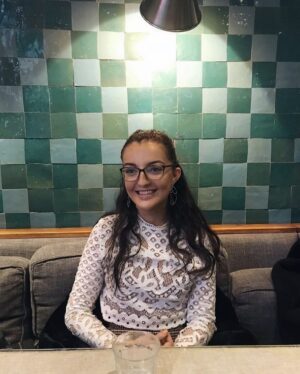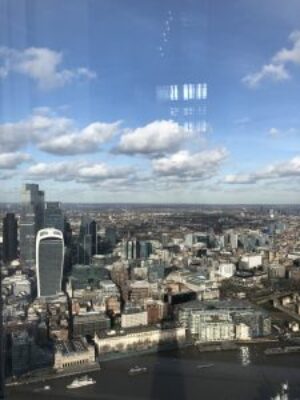
Hi there!
As a third year History of Art student at The Courtauld, I feel well equipped to inform you of a typical ‘week in the life’ of a BA student.
My name is Hollie, I came to The Courtauld from a sixth form college in Manchester after completing A-Levels in Classical Civilisation, History and French, (that’s right, no Art History here). Despite this, I have never felt a disadvantage with the content of the course.
During this year alone, the breadth of my studies has been immense, I’ve taken modules that cover photography, architecture and city planning in London, as well as reading theoretical and methodological studies of art history and preparing to write my dissertation on the conservation of digital art. I bet you’re wondering how I manage to fit this all in, and what a typical timetable might look like?
Study time at university is split between contact hours, these are lectures seminars and sometimes meetings with our personal tutors, essentially the taught aspect of the course, and independent study.

Contact Hours
Lectures typically happen inside a lecture theatre in a presentation type format and entail a lecturer speaking on a subject with some time at the end for questions, whereas seminars take place in smaller groups. This is the time we have for more in depth discussion, often relating to the lecture we had that week or the readings we were assigned.
These range from between 1 and 2 hours and typically you have 2 lectures a week with your whole year group, followed by one smaller seminar group. And two lectures or seminars for the module you have chosen to study that term.
Module seminars are in small groups of around 15 in your first year and reducing sometimes to around 5 by third year. And these don’t always take place inside the university building, often your lecturer will ask you to meet them at one of the many galleries and museums in London, or at a Library.
During my second module of this year, which was titled London: Building a Global City, you can imagine the advantage of being able to study outside of a classroom. Which mean the confines of where our seminars took place were really stretched, often during walking tours around the city guided by our lecturer, but also atop a boat on the Thames, the 72nd floor of the Shard and underground in the tube network.
I would also consider personal tutor meetings as contact hours, these are scheduled once per term with a lecturer that you are assigned for the full three years of the course, but you are also welcome to contact and meet them more often depending on your needs.
Independent Study
Studying at degree level means that you are no longer dependent solely on taught learning, there is much to be done independently. Readings are assigned for lectures and seminars and often you might be asked to prepare a presentation on a topic. When writing essays, independent research is a given.
There are multiple ways that I carry out independent study, and this takes up twice as much time in my week as the contact hours. There is often no end to how much independent study you could be doing! And I find it’s always good to shake it up as to how and where I do this.
Solitude often helps, and I mainly spend this time in Courtauld’s own library, as books we’ve been asked to read will always be in there, if not then the lecturer will scan and upload a copy of the required reading for you to access on the student system: Courtauld VLE.
However, when it comes to essays, I find that sometimes my research takes me beyond the means of The Courtauld library, as is the nature of a history of art degree, and so I like to make use of the many other libraries we have access to. Including the British Library, or the other University of London Libraries (like UCL), but also sometimes the Tate or Victoria and Albert Museums libraries (tip: these are often the quietest).
Another way to study outside contact hours may be to work together with other students, often groups get together to share the workload, meeting in our common room or cafes across London.
It’s important to note that independent study in an Art History degree does not always mean reading, a lot of this time may be spent getting up close and experiencing an object of study by going to museums, archives or exhibitions. Typically, I do this about once a week.
Extra-Curricular: what can you do at The Courtauld when you are not studying?
There are a number of ways to spend your free time at University. The Courtauld has a number of societies, including Art Society (where you can physically create works of art instead of read about them), Film Society, Architecture Society and LGBTQ+ Society. But you are not confined to just these, as a University of London institution we’re also able to join UCL, Kings, Goldsmiths and other universities societies. This is great for those who want to get involved with sports teams or connect with a wider network of students across London. Personally, I take part in King’s Yoga Society.
We also have a student publication, The Courtauldian, which you can get involved with, either writing or on the editorial team. In second year I participated as Head of Digital for The Courtauldian and thoroughly enjoyed the role and the new skills I gained from it.
On top of this there are multiple events put on by the Students Union across the year, including Winter and Summer Balls, Fresher’s Week and occasional movie nights.
Finally, we have an amazing resource at our fingertips here, the Research Forum has weekly events which inform of the latest research in art history, providing an even wider depth of study for students. These are attended by students as well as visitors and are a great place to discuss aspects of art history and immerse oneself further in the field.
Social life in London
What’s great about The Courtauld is that you are generally surrounded by extremely like-minded people who often share many of your interests, and so the social activities and possibilities are endless, especially in a city as vibrant and diverse as London. On a typical week I spend a few nights at friend’s flats, whether eating dinners we cook together or watching movies we haven’t seen. But also, as you would expect at university there are plenty of late nights for those that want them. I’ve explored a lot of different sides of London’s nightlife, often via apps like Resident Advisor, and there is really something for everyone. Music gigs are plentiful and club nights are varied depending on location and scene.
Despite what you also might think about the cost of such activities in London, I found quickly that there is a discount somewhere if you want to find it. Many of my friends scour apps like Dusk and Fever to budget their evenings out, and finding tickets to events early often means you can get early bird prices too.
For the quieter types, the food scene of London is worth exploring, I particularly love the food markets which have popped up over the last few years such as Seven Dials Market and Markethall West End and lots of outdoor eating places appear in spring and summer across London too.
Also, London has an array of beautiful parks which are great to stroll through or meet your friends in.
Where to find part-time work…
For many, part-time work may be a vital supplement to the cost of living in London, I myself have tried and tested an array of jobs during my three years here, including:
- Retail work
- Catering
- After School Nanny
For many, catering work is the best option, because it can be the most convenient. There are lots of agencies in London who hire students. Most of these will be zero hour contracts and so you often pick and choose your hours on a weekly basis, using an app where you book yourself on to the events you can work. This is a helpful job to have for when the university work piles up, as you can reduce your hours by week.
However, with such freedom often comes a lack of discipline and I found myself not really working often enough.
My favourite part time job so far has been as an after school nanny, again this is via an agency that hires mostly students. A few of my friends have found this to be the most suitable with our timetables, often involving 3 hours of work, 3-4 nights a week and sometimes babysitting later or at weekends when needed.
Whatever you decide, there are plenty of options for part-time work in London.